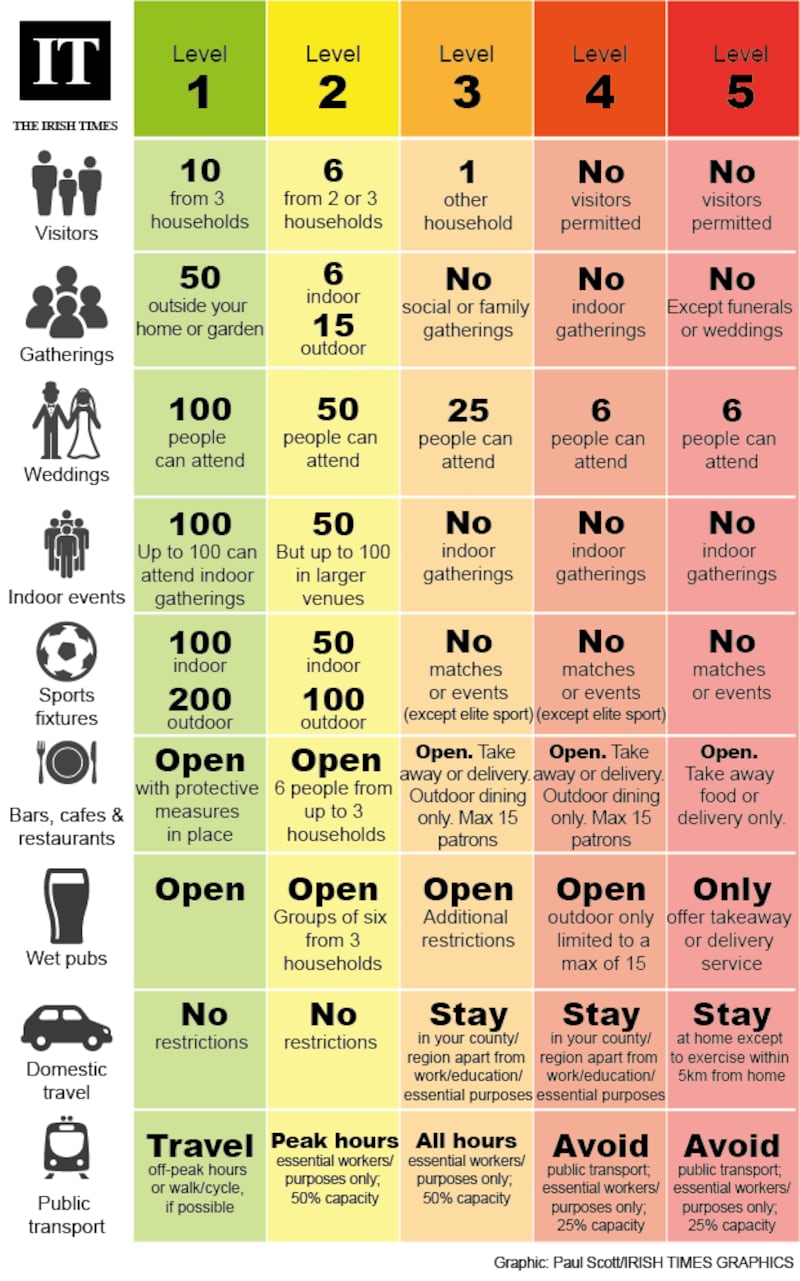Additional restrictions will be imposed in Dublin on home visits, indoor gatherings and care home visits while wet pubs in the capital will remain closed under the Government’s new, five-level coronavirus plan.
Taoiseach Micheál Martin said the Government’s medium-term Living with Covid-19 plan sets out “how we will live and how we will work with the virus”.
The plan involves a scale of restrictions from Level 1 to Level 5, with Level 5 being the most severe. The different levels can be implemented depending on conditions over the coming months. Currently the country is on Level 2.
Hospital Report
Despite Ministers expressing serious concern over a dramatic increase in cases in Dublin in recent weeks, the Cabinet has pulled back from moving the capital to Level 3, instead tailoring a number of extra conditions for the capital without changing the level.
“Current Covid numbers in Dublin are very worrying and the Government today has decided to introduce additional measures (for the capital),” said Mr Martin.
Tánaiste Leo Varadkar said pubs in the rest of the country will reopen as planned on September 21st and that 200 people will be allowed to attend events in large, outdoor stadia, with the possibility of more attending events in a stadium such as Croke Park.
He said the virus incidence has increased ten-fold in Dublin in the past month and unless there are preventative measures there will be “a second wave of hospital admissions, ICU admissions and possible deaths”.

Under Level 2 of the plan, 50 people can attend an indoor wedding, six people can visit a home and 15 people can gather in a garden.
On international travel, the State will adopt the European Union traffic light system which will be finalised in Brussels on October 13th.
Under the EU travel plan, the Government will drop the 14-day period of quarantine for non “green list” countries and instead adopt a system of testing at airports and ports for incoming passengers.

The plan says it will have to ensure this additional testing burden does not impact on the current plans to extend coronavirus testing and tracing.
The Government announced that the Pandemic Unemployment Payment will be open to new applicants until the end of the year, an extension of the previous closure date.
It was also announced that the Winter Plan Budget would be €600 million, an eight-fold increase on last winter.
“We are actually managing as a country to keep the virus down but it’s a longer haul than we thought originally. We have to keep at it but we will get there.... All the combined measures will keep the virus down and protect health and lives,” the Taoiseach said.
Earlier on Tuesday, Minister for Foreign Affairs Simon Coveney said officials wanted to ensure “trends they see in Dublin which is a rapid increase in the virus do not spread to the rest of the country.”
Minister for Health Stephen Donnelly, speaking on his way into the Cabinet meeting, said the new measures would be about “how we take the lead from public health doctors to do what we know works to stop this virus, to allow people to live their lives and protect the health care system, keep the schools open, protect jobs, protect lives. That’s what today will be all about”.
New official health figures show that Covid-19 infections in Dublin are continuing to rise. There are have been 95.1 cases of the disease for every 100,000 people in Dublin based on 14-day incidence rates, considerably higher than the next county, Louth, with 66.7 cases per 100,000.
Overall, the incidence rate nationally stands at 50 cases per 100,000, according to new statistics published by the Health Protection Surveillance Centre on Tuesday morning.
Another 208 confirmed coronavirus cases were reported by the National Public Health Emergency Team on Monday night, including 108 in Dublin. There were no new deaths.
The number of hospitalised patients has grown from 36 to 60 since the start of the month, while the number in intensive care has increased from six to 11.











